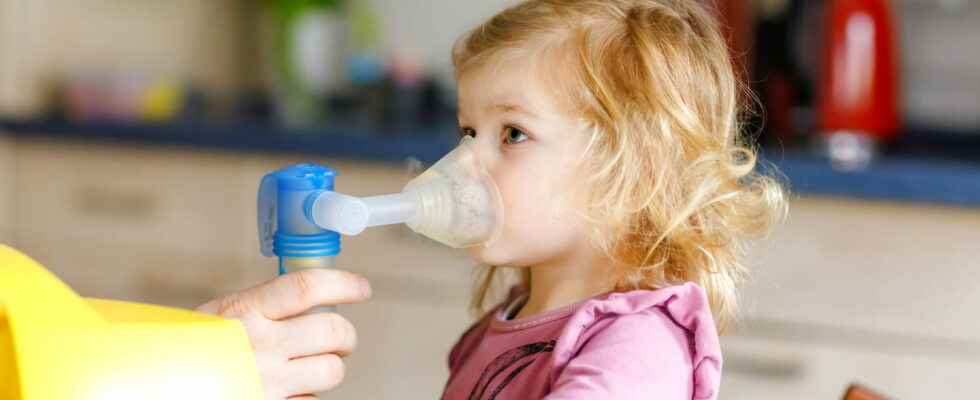In children, asthma follows a viral infection or can be caused by an allergen. Faced with certain warning signs, an emergency consultation is essential. List of recommendations.
Asthma is a chronic inflammatory disease of the airways. It is manifested by constriction of the airways and difficulty in breathing.
What is the definition of infant asthma?
“At the infantthere is no epidemiological data precise and the definition is not consensual. The lack of clarity in the definitions of asthma has favored the use of multiple periphrases: “asthmatic bronchitis”, “asthmatic cough”, “repeated bronchiolitis” “explain the High Authority of Health. It defines asthma in children under 36 months by:
- any dyspneic episode with sibilant rales, which has occurred at least three times since birth and this whatever the age of onset, the triggering cause, the existence or not of atopy.
- these episodes of wheezing are discontinuous, with periods during which the child is asymptomatic.
- other clinical pictures should suggest asthma: exercise-induced cough, nocturnal cough, chronic or recurrent cough, persistent cough after bronchiolitis, persistent wheezing.
What causes infant asthma?
We can distinguish two main types of asthma in children as detailed by Dr. Fabienne Kochert, pediatrician in Orléans: “Lvirus-induced asthma‘ more common before the age of 5: the wheezing episode follows a viral infection (bronchiolitis for example) and theallergic asthma : caused by airborne allergens (mites, animal hair, mold, pollen…): more frequent after the age of 5.” “Most asthma in infants is attributed to a delayed development of the small bronchi. This retarded growth of the respiratory system induces easier episodes of congestion and explains the symptoms during each viral infection. Finally, the children who present the highest risk of remaining asthmatic will be those in whom the “famous” allergic terrain that will predispose to relapses and/or persistent manifestations during childhood” completes Dr Sydney Sebban, pediatrician, in the book “Asthma under control” published by Editions Alpen.
What are the symptoms of asthma in children?
Asthma is manifested by difficulty breathing :
- rapid, wheezing breathing with periods during which the child is asymptomatic,
- sibilant rales
- exercise-induced cough,
- nocturnal cough,
- chronic or recurrent cough,
- persistent cough after bronchiolitis,
- persistent hissing.
‘What should be striking is the recurrent and/or prolonged nature of the respiratory manifestations” emphasizes Dr. Sebban. Signs of seriousness are pallor, fatigue, feeding difficulties, poor oxygenation (blue lips). As soon as these symptoms appear, it is recommended to consult urgently.
“Whistling children may be misdiagnosed as bronchitis, bronchiolitis”
During the consultation, the doctor examines the infant for signs of asthma. He then conducts an interrogation with the parents in order to determine the frequency of the seizures, the family history, the triggering factors, etc. “Whistling children may be misdiagnosed as bronchitis, bronchiolitis, pneumopathy, gastroesophageal reflux or ENT infections when their symptoms are suggestive of asthma due to their recurrent nature. This may delay the start of treatment” warns the HAS. Are in favor of the diagnosis of asthma the presence of the following signs:
- the repeated bouts of coughing and wheezing (≥ 3), often favored by viral infections, irritants in particular environmental smoking, exercise or emotions;
- the nocturnal predominance symptoms;
- the normality of the clinical examination between attacks, and the absence of repercussions on the height-weight curve.
- the presence of personal (atopic eczema, allergic rhinitis, food allergy) and family signs of atopy (asthma, allergic rhinitis and aopic eczema in parents and/or siblings). However, their absence should not cause the diagnosis to be abandoned.
- frontal chest X-ray is essential
- the effectiveness of a test anti-asthmatic treatment reinforces the diagnosis
60-70% of infants will recover from this condition by preschool age (3-4 years)
What are the treatments for asthma in children?
“The treatment has two parts. The first is symptomatic with a bronchodilator (salbutamol) and background treatment with inhaled cortisteroids”, explains Dr. Kochert. This background treatment helps to control asthma and give the child a normal life. “Parents will be reassured to learn that 60-70% of infants will recover from this condition by preschool age (3-4 years)” says Dr. Sebban.
What are the risks of complications?
The main complication is thestatus asthmaticusIt’s about a asthma attack that gets worse and lasts longer. This is a life-threatening emergency that requires intensive care. Less serious is respiratory superinfection in case of viral infection, which will require antibiotic treatment
First of all, it is imperative toavoid passive smoking. In case of allergic asthma: avoid exposure to allergens or offer desensitization treatment. Anti-allergy treatments can also be offered. It is also recommended to follow hygiene measures in times of viral infection (wash your hands well with soapsneeze into a disposable tissue, put on a mask, wash your child’s nose wellprohibit pets from entering the room).
Thanks to Dr Fabienne Kochert, pediatrician in Orléans and president of the French Association of Ambulatory Pediatrics (AFPA).
Source: Asthma in children under 36 months: diagnosis, care and treatment outside of acute episodes, HAS, 2009. / “Asthma under control”, Dr Sydney Sebban, 2006, Editions Alpen.
